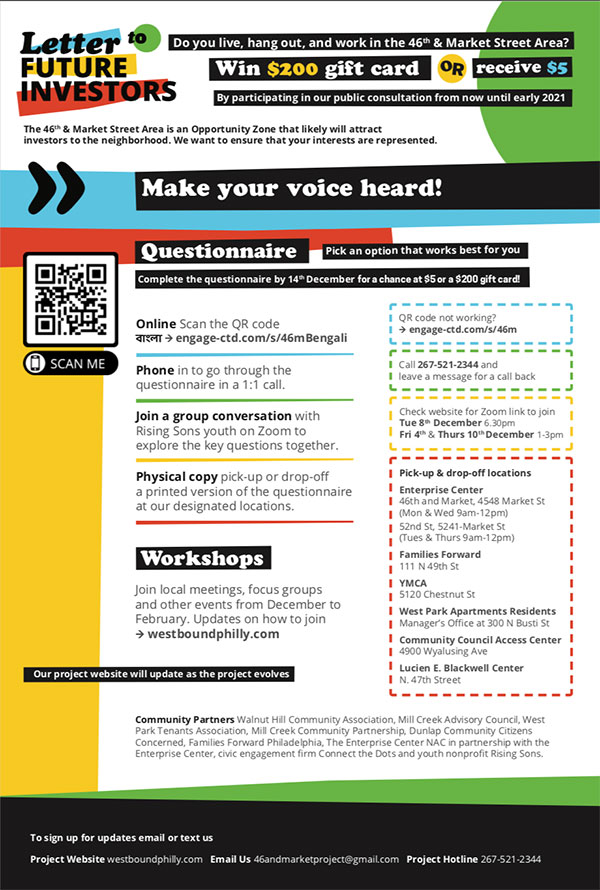Letter to Future Investors – West Philadelphia

Client:
Enterprise Center
Collaborators:
The Enterprise Center in West Philadelphia, September 2020
Project Summary:
The primary project area of 46th and Market neighborhood in West Philadelphia is designated as an Opportunity Zone, and as such, is likely to attract investors to the neighborhood. This effort was intended to collect community input about how residents would like to see equitable development happen in their neighborhoods, and how new investment can help collectively build wealth in those places. The project (still ongoing) centered around the goal of creating a “Letter to Future Investors” that will serve as the first port of call for investors looking into the area (via inclusion in the Department of Commerce / LIndy Institutes Investor Prospectus) and as a negotiating tool for those who will be negotiating with them (like the Enterprise Center, community groups, the City and the Councilmembers) to make sure community interests are represented.
During this consultation, there were many other major issues at hand: not least of all COVID-19, BLM marches and civil unrest, presidential election. We needed to be very sensitive to consultation overload in a community bombarded with requests to vote, answer census questions, and one that had just been through a major planning effort. We needed to be sensitive to the topic itself; there are worries /tensions around development, gentrification, anti-racism, BLM, and more. There was a need to integrate the insights of the community in a responsible way: where do these insights ultimately go? Who should shepherd these ideals in the future? We were also facing challenges of socially distanced engagement and Digital divide, so we carefully devised multiple layers of consultation that ran in tandem, all with various levels and types of opportunities for input.
Methods:
- Honed in on findings from previous consultations to ensure we were building from them and consulting only to refresh them, see what’s relevant now, and what are new opportunities or ideas & to highlight what is relevant & key community priorities to investors / Investor Prospectus
- Developed strong partnerships with 7 community-based organizations in the area and included them as paid (of course) members of our extended team for this project
- Co-designed engagement mechanisms to meet people where they are:
- Engaged in a plethora of 1-1 phone calls with 100s of key nodes in the area to introduce our team, the project, gather ideas/concerns regarding the consultation design, and build participation for the next steps
- Worked with our 7 key partners and Enterprise Center to develop engagement streams and iteratively design them with multiple feed-in and feedback points along the way
- Developed multiple streams of engagement, responding to different levels of comfort with digital, different levels of capacity (emotional and in general), and different levels of interest – so that residents could come across and choose which of the options worked best for them as to how to share their perspective, confidently and without feeling pressure
- Engagement streams running concurrently included online survey (on our Engage platform), paper surveys (designed in collaboration with community ambassadors to best engage residents and distributed to our partners to disseminate in the way that worked best for them and their communities (ie storefronts, centers, distribution to residents under doors at complex, handed out at neighborhood events), call-in version of the survey for those who wanted additional support (via Google Voice hotline), youth-focused online chat sessions with our partner Rising Sons, and remote workshop discussions for those who wanted to talk through the questions in collaboration with others.
- Translations were also made available in Bengali to ensure inclusivity
Results:
Built long-lasting relationships with community partners that can continue to serve the area and Enterprise’s Centers collaboration with them
Helped to further develop the capacity of community partners via training sessions/capacity building workshops focused on equitable engagement methods and the topics of the project
100+ 1-1 calls with community members
350+ responses to survey alongside multiple participants to online sessions and workshops (more to come)
Letter to Future Investors in development that will continue to be updated and refreshed year on year to ensure it remains relevant and useful to local community groups and members
